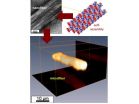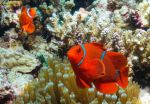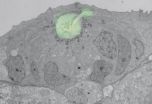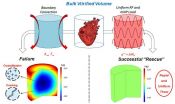NYU researchers break nano barrier to engineer the first protein microfiber
New material advances tissue engineering and drug delivery
2014-10-23
(Press-News.org) Researchers at the New York University Polytechnic School of Engineering have broken new ground in the development of proteins that form specialized fibers used in medicine and nanotechnology. For as long as scientists have been able to create new proteins that are capable of self-assembling into fibers, their work has taken place on the nanoscale. For the first time, this achievement has been realized on the microscale—a leap of magnitude in size that presents significant new opportunities for using engineered protein fibers.
Jin Kim Montclare, an associate professor of chemical and biomolecular engineering at the NYU School of Engineering, led a group of researchers who published the results of successful trials in the creation of engineered microfiber proteins in the journal Biomacromolecules.
Many materials used in medicine and nanotechnology rely on proteins engineered to form fibers with specific properties. For example, the scaffolds used in tissue engineering depend on engineered fibers, as do the nanowires used in biosensors. These fibers can also be bound with small molecules of therapeutic compounds and used in drug delivery.
Montclare and her collaborators began their experiments with the intention of designing nanoscale proteins bound with the cancer therapeutic curcumin. They successfully created a novel, self-assembling nanoscale protein, including a hydrophobic pore capable of binding small molecules. To their surprise, after incubating the fibers with curcumin, the protein not only continued to assemble, but did so to a degree that the fibers crossed the diameter barrier from the nanoscale to the microscale, akin to the diameter of collagen or spider silk.
"This was a surprising and thrilling achievement," said Montclare, explaining that this kind of diameter increase in the presence of small molecules is unprecedented. "A microscale fiber that is capable of delivering a small molecule, whether it be a therapeutic compound or other material, is a major step forward."
Montclare explained that biomaterials embedded with small molecules could be used to construct dual-purpose scaffolds for tissue engineering or to deliver certain drugs more efficiently, especially those that are less effective in an aqueous environment. Using microscopy, the team was able to observe the fibers in three dimensions and to confirm that the curcumin, which fluoresces when bound to structural protein, was distributed homogeneously throughout the fiber.
Despite the enormity of the jump from nano- to microscale, the research team believes they can devise even larger fibers. The next step, Montclare says, is developing proteins that can assemble on the milliscale, creating fibers large enough to see with the naked eye. "It's even possible to imagine generating hair out of cell assembly," she says.
INFORMATION:
Researchers from three institutions collaborated on this work. In addition to Montclare, NYU School of Engineering doctoral candidate Jasmin Hume, graduate student Rudy Jacquet, and undergraduate student Jennifer Sun co-authored the paper. Richard Bonneau, an associate professor in NYU's Department of Biology and a member of the computer science faculty at NYU's Courant Institute of Mathematical Sciences, and postdoctoral scholar P. Douglas Renfrew also contributed, along with M. Lane Gilchrist, associate professor of chemical engineering at City College of New York and master's degree student Jesse A. Martin, also from City College. Their work was supported by the Army Research Office and the National Science Foundation.
The full study, "Engineered Coiled-Coil Protein Microfibers," is available at http://pubs.acs.org/doi/pdf/10.1021/bm5004948).
[Attachments] See images for this press release:

ELSE PRESS RELEASES FROM THIS DATE:
2014-10-23
In this image taken by the Aqua satellite of the southern United States actively burning areas as detected by MODIS's thermal bands are outlined in red. Each red hot spot is an area where the thermal detectors on the MODIS instrument recognized temperatures higher than background. When accompanied by plumes of smoke, as in this image, such hot spots are diagnostic for fire. These fires are a combination of small wildfires and prescribed fires. On the U.S. Forest Service website a prescribed fire is set to reduce tree overcrowding, revive fire-dependent species and reduce ...
2014-10-23
Despite a dramatic increase in public awareness and anti-bullying legislation nationwide, the prevalence of bullying is still one of the most pressing issues facing our nation's youth, according to a report by researchers from Clemson University and Professional Data Analysts Inc., and published by the Hazelden Foundation.
"Bullying continues to affect a great number of children in all age groups, with the highest prevalence observed in third and fourth grades, where roughly 22 percent of schoolchildren report that they are bullied two or three times or more per month," ...
2014-10-23
A new test, developed by University of British Columbia researchers, could help physicians predict within an hour if a patient will develop severe sepsis so they can begin treatment immediately.
Sepsis, a syndrome caused by infection, leads to organ failure and is responsible for up to five million deaths annually. There are 18 million cases of sepsis worldwide every year.
The discovery could cut back on the lengthy diagnostic time usually required to confirm if a patient is suffering from sepsis and increase the odds that they will respond to treatment.
"We identified ...
2014-10-23
Scientists have found a molecule that could potentially accelerate clinical trials to combat autoimmune diseases.
Researchers from the Australian Regenerative Medicine Institute (ARMI) at Monash University and the European Molecular Biology Laboratory (EMBL) in Italy believe the molecule, called insulin-like growth factor-1 (IGF-1), could play a key role.
Autoimmune diseases occur when a group of immune cells called pro-inflammatory T-effector cells become sensitised to specific cells in the body, identifying them as foreign and attacking them as if they were invading ...
2014-10-23
Sediments associated with dredging and flood plumes could have a significant impact on fish populations by extending the time required for the development of their larvae, according to Australian researchers.
"Sediment concentrations at levels found in plumes from dredging or in floods cause a significant delay in the development of clownfish larvae," says study lead author, Dr Amelia Wenger, from the ARC Centre of Excellence for Coral Reef Studies (Coral CoE) at James Cook University.
"This in turn could significantly reduce the numbers of larvae competent to settle ...
2014-10-23
Loggerhead turtles (Caretta caretta) from Cape Verde start their life with a swimming sprint and a ride on favourable ocean currents. In this way, they escape quickly from predator-rich coastal areas and make their way to the safer open ocean where they spend several years feeding and growing. In this study, tiny acoustic transmitters provided direct insight into these pathways for the first time. "Thanks to the new technology we can start to fill in key information gaps about the so-called 'lost years' Dr. Rebecca Scott states. Funded by the Kiel Cluster of Excellence ...
2014-10-23
From basketball to handball, rugby to American football, teams in a variety of sports huddle together to agree tactics in secret. Cells, too, can huddle to communicate within a restricted group, scientists at the European Molecular Biology Laboratory (EMBL) in Heidelberg, Germany, have found. The study, published today in Nature, is the first demonstration that the way cells organise themselves influences their ability to communicate. The researchers propose that this strategy, which they discovered in developing zebrafish, could be much more widespread, influencing processes ...
2014-10-23
Successful techniques for cryopreserving bulk biomaterials and organ systems would transform current approaches to transplantation and regenerative medicine. However, while vitrified cryopreservation holds great promise, practical application has been limited to smaller systems (cells and thin tissues) due to diffusive heat and mass transfer limitations, which are typically manifested as devitrification and cracking failures during thaw. Here we leverage a clinically proven technology platform, in magnetically heated nanoparticles, to overcome this major hurdle limiting ...
2014-10-23
Narrowband or hyperspectral imaging is a valuable technique used in planetary science for characterizing surfaces and surrounding environments. For example, it can be used to spatially map molecular species of interest on the surface of a solid or icy body, or to sound to different depths in a giant planet atmosphere. However, conducting narrowband or hyperspectral imaging of solar system targets from a balloon-borne platform presents several technical challenges, including mechanical failures and power requirements. These risks can be mitigated with the use of an electronically ...
2014-10-23
Amsterdam, October 23, 2014 - Herbal medicines such as licorice, Indian rennet and opium poppy, are at risk of contamination with toxic mould, according to a new study published in Fungal Biology. The authors of the study, from the University of Peshawar, Pakistan say it's time for regulators to control mould contamination.
An estimated 64% of people use medicinal plants to treat illnesses and relieve pain. The herbal medicine market is worth $60 billion globally, and growing fast. Despite the increasing popularity of herbal medicine, the sale of medicinal plants is mostly ...
LAST 30 PRESS RELEASES:
[Press-News.org] NYU researchers break nano barrier to engineer the first protein microfiber
New material advances tissue engineering and drug delivery





